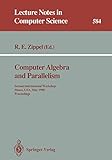Computer Algebra and Parallelism [electronic resource] : Second International Workshop Ithaca, USA, May 9–11, 1990 Proceedings / edited by Richard E. Zippel.
Material type: TextSeries: Lecture Notes in Computer Science ; 584Publisher: Berlin, Heidelberg : Springer Berlin Heidelberg, 1992Description: XI, 117 p. online resourceContent type: text Media type: computer Carrier type: online resourceISBN: 9783540470267Subject(s): Computer science | Computer system performance | Computer software | Algebra -- Data processing | Algebra | Algorithms | Numerical analysis | Computer Science | Symbolic and Algebraic Manipulation | System Performance and Evaluation | Algorithms | Numerical Analysis | Algorithm Analysis and Problem Complexity | AlgebraAdditional physical formats: Printed edition:: No titleDDC classification: 005.131 LOC classification: QA76.9.M35Online resources: Click here to access online
TextSeries: Lecture Notes in Computer Science ; 584Publisher: Berlin, Heidelberg : Springer Berlin Heidelberg, 1992Description: XI, 117 p. online resourceContent type: text Media type: computer Carrier type: online resourceISBN: 9783540470267Subject(s): Computer science | Computer system performance | Computer software | Algebra -- Data processing | Algebra | Algorithms | Numerical analysis | Computer Science | Symbolic and Algebraic Manipulation | System Performance and Evaluation | Algorithms | Numerical Analysis | Algorithm Analysis and Problem Complexity | AlgebraAdditional physical formats: Printed edition:: No titleDDC classification: 005.131 LOC classification: QA76.9.M35Online resources: Click here to access online  E-BOOKS
E-BOOKS
| Current library | Home library | Call number | Materials specified | URL | Status | Date due | Barcode |
|---|---|---|---|---|---|---|---|
| IMSc Library | IMSc Library | Link to resource | Available | EBK5959 |
The S-threads environment for parallel symbolic computation -- Algebraic computing on a local net -- An environment for parallel algebraic computation -- Finite field arithmetic using the connection machine -- Embarrassingly parallel algorithms for algebraic number arithmetic — and some less trivial issues -- Parallel real root isolation using the coefficient sign variation method -- Very large Gröbner basis calculations -- Boolean Gröbner bases and their MIMD implementation.
This book contains papers presented at a workshop on the use of parallel techniques in symbolic and algebraic computation held at Cornell University in May 1990. The eight papers in the book fall into three groups. The first three papers discuss particular programming substrates for parallel symbolic computation, especially for distributed memory machines. The next three papers discuss novel ways of computing with elements of finite fields and with algebraic numbers. The finite field technique is especially interesting since it uses the Connection Machine, a SIMD machine, to achievesurprising amounts of parallelism. One of the parallel computing substrates is also used to implement a real root isolation technique. One of the crucial algorithms in modern algebraic computation is computing the standard, or Gr|bner, basis of an ideal. The final two papers discuss two different approaches to speeding their computation. One uses vector processing on the Cray and achieves significant speed-ups. The other uses a distributed memory multiprocessor and effectively explores the trade-offs involved with different interconnect topologies of the multiprocessors.


There are no comments on this title.